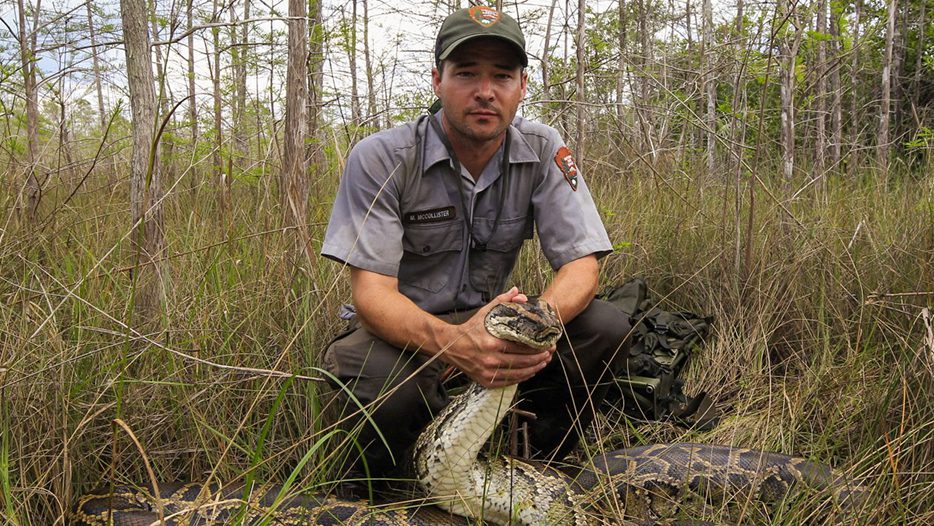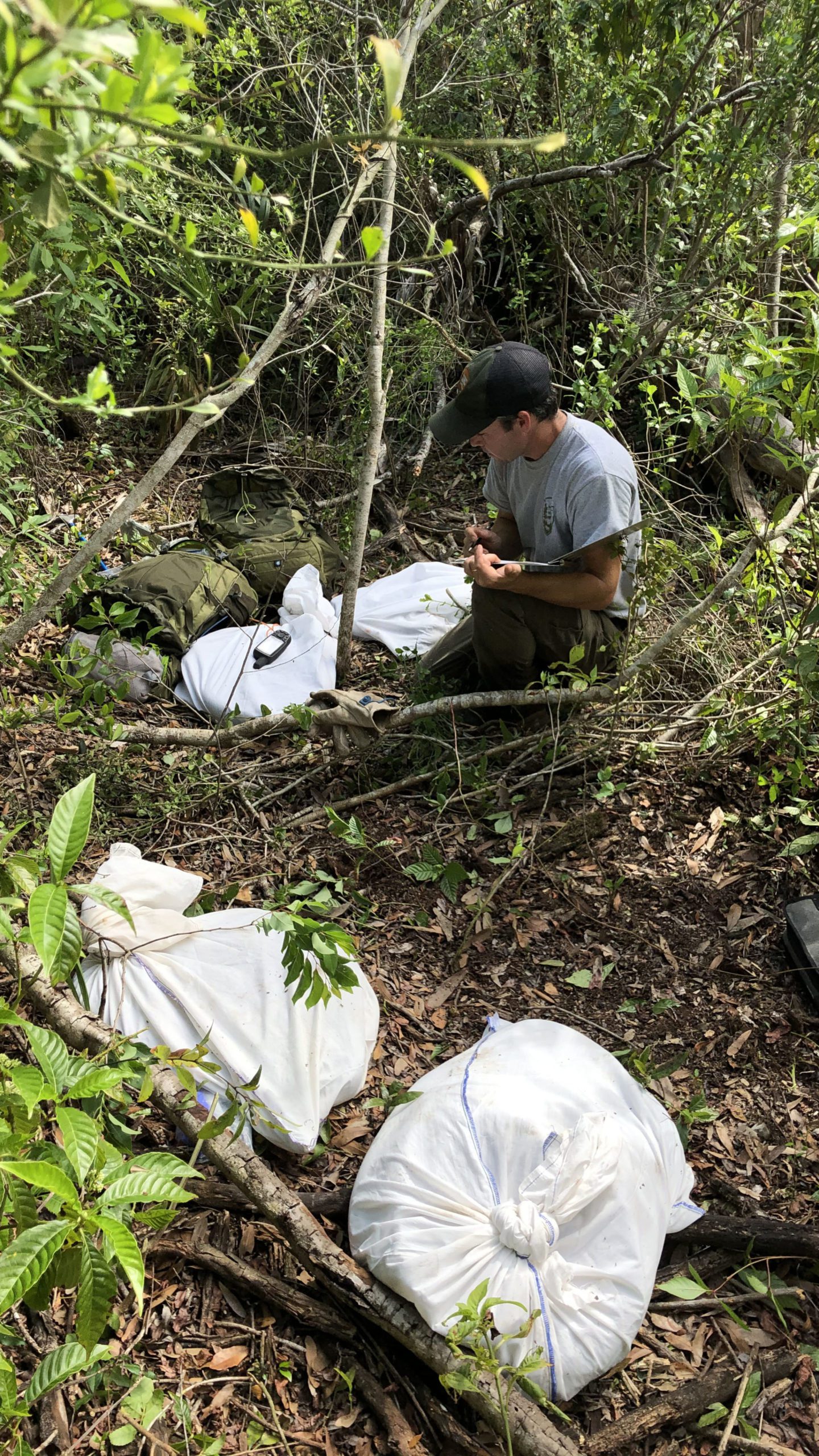On the front lines of Florida’s fight against Burmese pythons

Though he received far more screen time, wildlife biologist Matthew McCollister ’05 knew the star of the April 20 episode of ABC’s “Rock the Park” would be the Burmese pythons he helped hosts Jack Steward and Colton Smith show their viewers. McCollister just hoped his supporting role in “Researching Pythons in Florida’s Big Cypress National Preserve” would end up educating rather than sensationalizing.
He was happy to see it did.
“They were nice guys. This snake stuff is just a really weird media monster,” McCollister said. “They didn’t say anything that was incorrect, and they seemed to value more than just the sensational aspects of it.”

McCollister uses an antenna to track a male Burmese python implanted with a radio transmitter. (Photo credit: Kirsten Hines)
For two years, McCollister has been part of team of researchers at Big Cypress National Preserve working to figure out how to control the population of the invasive pythons, which have been breeding and expanding across the state since the 1980s. Steward and Smith tapped that expertise to lead them into the cypress swamps of south Florida, and a good part of the episode was dedicated to following McCollister as he tracked a male python implanted with a radio transmitter.
Though he knew he was standing nearly on top of it, McCollister nevertheless had difficulty seeing the snake hiding in thick grass, which was a perfect representation of just how daunting of a challenge the predators pose: Despite being one of the largest snakes in the world, Burmese pythons are virtually impossible to find.
“People don’t really understand until they’re in the field with us, but it’s unbelievable about how a 130-pound animal is not visible,” McCollister said. “One of the major roots of the issue is we do not have ways to detect pythons.”
The huge majority of pythons are captured while crossing roads, usually at night in the summer and fall, and Big Cypress’ 729,000 acres are largely roadless. Most of the time, they transition from water (where they can hold their breath for up to 30 minutes) to trees to deep brush and grass, blending to the point of invisibility in places that humans and even dogs find very difficult to navigate.
That elusiveness means nobody knows how many snakes there are in Florida, but undoubtedly there are thousands – and their effects on the ecosystem have been devastating. A 2012 study conducted in the southernmost regions of Everglades National Park showed a 99.3% drop in raccoon populations, 98.9% drop in opossums and 87.5% in bobcats since 1997, with marsh rabbits, cottontail rabbits and foxes almost gone completely. All have been regularly found in python stomachs.
A large constrictor snake hasn’t existed in North America for millions of years, meaning animals have evolved no way to defend themselves against that type of predation. It’s possible many simply don’t even realize the snakes are threats, and that is only one of the many python competitive advantages.
In the jungles of southeast Asia where they’re from, Burmese pythons must fear a number of large predators themselves – including crocodiles, monitor lizards, king cobras, other pythons, honey badgers and tigers – but no such natural population control exists in Florida. Once they’re a few years old, there is nothing big enough to threaten the snakes outside of alligators and the rare American crocodile.
“Alligators are probably our best native predator against them, and they probably take a lot of small snakes. But once snakes get to a certain size they’re a lot safer,” McCollister said. “A 15-foot female python is not really going to get eaten by anything.”
But she, like other pythons, is able to eat almost everything that moves, so even if the mammals are gone the snakes can prey on birds (which migrate through south Florida by the thousands every year) and other reptiles, including alligators. Low metabolic rates also allow them to go as long as a year without eating at all if necessary.

McCollister surrounded by bags containing a female and three male pythons captured at a “breeding aggregation.”
“A deer runs out of food, and in 10 days it’s dead. A big python runs out of food, and a year later it’s waiting for that next baby raccoon to be born,” Furman Professor of Biology Travis Perry ‘92 said. “Now, these pythons aren’t magical. They still have to conform to the laws of physics … but because of their metabolisms, they can wait out that food decline for a very long period of time until those populations of prey start to rebound, and then they can just hammer them again.”
Compounding the problem is that Burmese pythons are prodigious egg layers with long lifespans (more than 20 years). It is even far from certain that colder temperatures will prevent a spread northward. Researchers with the Conservancy of Southwest Florida, based in Naples, have shown pythons spending time in burrows.
“How far do armadillo holes go in the South?” McCollister said. “And if that’s a consistent 55 degrees, could pythons persist throughout the winter? It’s unknown how far pythons could expand.”
The sweeping scope of the threat is the reason McCollister found himself working with a reptile for the first time in his career. Python control has become a top priority for the entire region, and Big Cypress National Preserve has teamed with Conservancy of Southwest Florida, the U.S. Geological Survey, the U.S. Fish and Wildlife Service and Crocodile Lake National Wildlife Refuge to share resources and data.
“We know a lot about deer now, but we’ve also been studying them for over a century. Python research is very limited, and to be honest we probably know more about Burmese pythons in Florida than in their native range,” McCollister said. “So we’re starting at ground zero and taking baby steps, and everything we learn is virtually new.”
McCollister grew up in Montgomery, Alabama, and brought a lifelong love of the outdoors to Furman. Perry has been a pioneer in field ecological education at the university, and in McCollister he found a student who shared his passion. “We hit it off, and he really looked out for me,” McCollister said.
McCollister took nearly every course Perry taught, including travel study classes to multiple countries, and after graduation he trapped mountain lions for the “Furman Cougar Project,” Perry’s ongoing research in New Mexico. As a student, McCollister proved his mettle to the point that Perry recommended him for a rugged summer internship with the U.S. Fish and Wildlife Service at the remote Togiak National Wildlife Refuge in Alaska conducting a walrus census.
McCollister calls it the hardest job he’s ever had, but Perry knew he was one of the few who could handle it.
“You have to be extraordinarily motivated and self-disciplined (to be a wildlife biologist),” Perry said. “You also have to be willing to work really, really hard and not be afraid of reasonable levels of physical discomfort and deprivation.”
After Furman, McCollister also worked on desert bighorn sheep recovery before moving to black bear research in coastal North Carolina while earning a master’s degree in wildlife and fisheries from the University of Tennessee. He also had a stint trapping grizzly bears in Montana, developing confidence that allowed him to shrug at the prospect of handling a snake that can exceed 20 feet and 200 pounds.
“Some of the first encounters with really large animals, it took a little bit to get comfortable with,” he said, “but if you go about it right you can handle it. We haven’t had a large snake get away from us yet.”
That includes the largest Burmese pythons recorded on the preserve and among the biggest caught in the state – a 17-foot, 6-inch, 143-pound female in 2019 and a 17-foot, 2-inch, 152-pound female earlier this year. The team locates breeding females by following the radio signal coming from a male hoping to mate, and that strategy of using males to locate and remove large females before they can make more snakes has emerged as the best – and only – control strategy in backcountry habitats.
“We can’t detect a python, and we cannot attract it,” McCollister said. “But for four months of the year (during mating season) they can detect and attract each other.”
Still, McCollister is blunt when he says these efforts so far have probably had little effect.
“I believe that the animals that are removed is not a significant number, and our real focus is trying to learn more so that we can develop better tools,” he said. “Everybody wants a silver bullet, and it almost never exists. It really takes hard-won successes that have to be added to other hard-won successes to start turning the tide a little bit.”
Fortunately for McCollister, he seems to enjoy success at that price.
“I appreciate the lifestyle. I appreciate getting to be in backcountry conditions, to work alone, to work as part of a team, to have a challenging task, to learn new places,” he said. “And there’s a benefit to feel like there’s a chance I could improve public resources while I’m at it.”
Watch the April 20 episode of “Rock the Park” below: